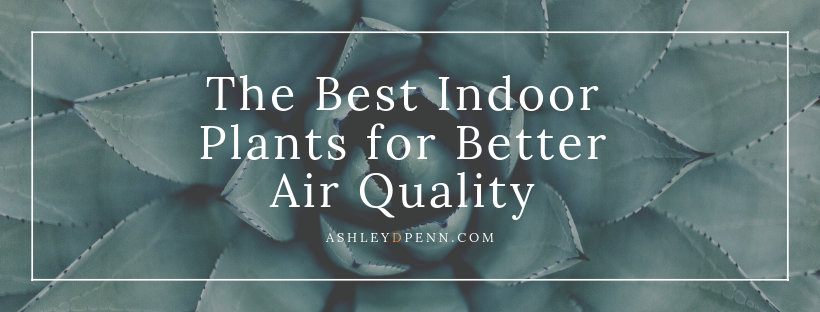Having a lung disease (chronic pulmonary sarcoidosis), I am always looking for ways to improve the air quality in my home. Also being a keen gardener I love to make those improvements using plants, which have a range of other benefits as well. In this blog, I would like to share with you some of the best houseplants I’ve come across for improving indoor air quality.
The air in our homes can be unhealthy due to a number of factors including low humidity, higher pollution, dust, and reduced negative ions (see my other post, How Landscape Architecture Can Make You Healthier). All of which can contribute to ‘Sick Building Syndrome‘ (SBS). While SBS might sound like a conspiracy theorist’s made up term, the NHS states that it can have some very real symptoms, including:
-
- Headaches and dizziness
-
- Nausea (feeling sick)
-
- Aches and pains
-
- Fatigue (extreme tiredness)
-
- Poor concentration
-
- Shortness of breath or chest tightness
-
- Eye and throat irritation
-
- Irritated, blocked or runny nose
- Skin irritation (skin rashes, dry itchy skin)
(taken from SBS symptoms page of NHS Choices)
Plants are able to mitigate these symptoms through photosynthesis, which removes carbon dioxide from the air and replaces it with oxygen. They also filter the air removing particulate pollution and absorbing pollutant gases. Finally, they can also cool and humidify the air through transpiration.
However, not all plants are created equal. If you would like to maximise the benefits of having plants in your home then check out these six easy-care houseplants for better quality air.
Devil’s Ivy (Epipremnum aureum)
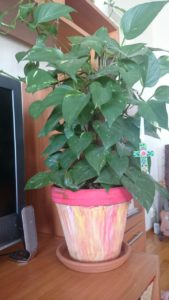
Devils Ivy
I picked up this Devil’s Ivy at my local supermarket. They initially stocked a great number of them, and after a week reduced the price of the remaining few, so I snapped it up quickly for a bargain price! One common theme you may notice in these pictures is that almost all of our plant pots have been painted by our daughter. I quite like the striking fiery colours of this one.
Devil’s Ivy has been identified by NASA as being one of the best plants for indoor air quality. This is largely due to its capacity to remove toxins such as benzene, formaldehyde and trichloroethylene from our air. Devil’s Ivy grows very quickly. Mine has doubled in size since I bought it about 8 months ago. But then I shouldn’t boast as the reason it is called Devil’s Ivy is that it is so difficult to kill! Anyone can grow one. It has to be one of the most forgiving houseplants I have ever come across. It benefits from being in quite a large pot and having plenty to drink. I also feed it once a week during the growing season with a proprietary indoor plant food.
As a bonus, the Devil’s Ivy is incredibly easy to propagate. I managed to take a layer from this parent plant into my Mother-in-Law’s Tongue’s pot (see below). I simply laid a shoot across the pot, pegged it down, and then cut it loose from its parent once it had taken root after a few weeks. Now I have two Devil’s Ivies for the price of… well less than one!
Mother-in-Law’s Tongue (Sansevieria trifasciata)

Mother-in-Law’s Tongue
I have forgotten the exact variety of this Mother-in-Law’s Tongue as I have had it many years. In fact, I think it was one of the first houseplants that my wife and I bought when we moved to Finland. Sansevieria is often also known as the Bedroom Plant. This hints at one of the main reasons this houseplant is so good for indoor air quality. Mother-inLaw’s Tongue has the ability to release quite a lot of oxygen at night, therefore improving your sleep quality, and helping you feel refreshed in the morning. In truth, one needs many more plants than I have to feel the full effect (something like 3-5 plants per person), but it is such a beautiful plants, that I think it is a great addition to any home. Having said that, Mother-in-Law’s Tongue is so easy to propagate from leaf cuttings that you might find you have those 3-5 plants after a little while. I think I’ll give it a go taking a cutting this year!
Common Ivy (Hedera helix)

Ivy
Believe it or not, the Common or English Ivy is a very good plant for purifying the air. It is thought that for people with sarcoidosis there is an initial irritant or particle that a suffer breaths in which starts an overactive immune response. While the immune system’s response is key to why people with sarcoidosis get sick, it is also important to maintain good air quality. Mould can be a particular problem. Ivy has the ability to reduce airborne mould particles by as much as 94%! Ivy is also very easy to care for and propagate. I have just taken a couple of cuttings from this one in the last week. I took two sections with a couple of nodes on each (where leaves come from the main stem), cut them off, and popped them in a glass of water on the kitchen table (where the cuttings will receive indirect sunlight). I can’t see any roots forming yet, but it’s early days. When I see the roots growing I shall plant them up in a couple of left-over 9cm pots I have. Actually, I think I need to repot this one… Christmas was a while ago.
Red Edged Dracaena (Dracaena marginata)
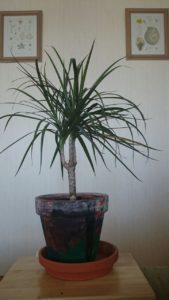
Red Edged Dracaena
Dracaena is another powerful pollutant removing houseplant for better air quality. NASA endorses this plant for removing formaldehyde and benzene, two common household pollutants found in everything from paints to fabric dyes.
I must admit I haven’t always been successful with Dracaena. They can be very sensitive to over-watering. I find it is best to let mine dry out almost completely before giving it a good soak. Otherwise, Dracaena are relatively easy to care for. The leaves can be toxic to cats, so they are best placed far from feline temptation. Although these plants are sold as small house plants, often in tiny pots, they can grow to quite a size. It is not unheard of for Dracaena to grow to 3 m tall. Having said that, they are not very fast growing, so you will get many years of enjoyment from a Dracaena before you need to worry about it hitting the ceiling. Being an African native, place it where it will get plenty of indirect sunlight all day long.
Zanzibar Gem or Zulu Palm (Zamioculcas zamiifolia)
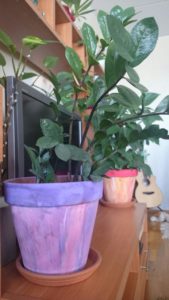
Zamioculcas zamiifolia
This intriguing plant isn’t actually mine. My wife has had it since before she met me. Our best estimate is that she has had it for about 15 years. Zamioculcas has only been widely cultivated since the mid-1990’s, so it is a bit of a ‘new kid on the block’ when compared to some of our Victorian houseplants. The Zanzibar Gem is one of the most difficult indoor plants to kill. Being a forest floor plant, native to Kenya, it can cope with very low levels of light, and water. It is, therefore, the ideal choice for those who have a habit of killing house plants. It is also has a high resistance to pests.
The Zanzibar Gem benefits from being in a smaller pot. I repotted this one last year from a 15cm pot in which it had been for many years. As soon as I did so it grew a new shoot, however, it has stayed pretty dormant ever since. If you have the patience, Zanzibar Gem is really easy to propagate. Simply pull off one of the leaves, cut the last few millimetres off the leaf, let it dry a little, and pot it up in free draining compost. Be aware Zamiocalcus is notoriously slow, so be prepared for nothing to happen for up to a year! See the YouTube video below.
When it comes to cleaning the air the Zanzibar Gem is particularly good at removing Volatile Organic Compounds or VOCs for short. In one study a specimen was dosed with benzene and monitored. The scientists noted that all traces of benzene had been removed by the Zamioculcas within 48 hours.
Zebra Plant (Calathea)
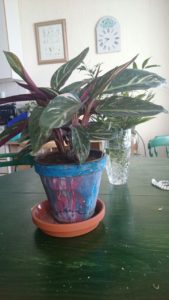
Zebra Plant
This tropical leafy plant from the floor of the Amazonian rainforest is a beautiful addition to any home. There are so many varieties offering wavy, striped, and often purple foliage. To be honest, I’m not sure exactly what variety this is, as again, it was rescued from my local supermarket where it was looking decidedly droopy. Supermarket purchases are notoriously poorly labelled. (EDIT: I think I’ve since worked out mine is a C. triostar). Being a forest floor plant it tolerates shade very well, and in fact, should be kept away from direct sunlight. One interesting habit of Calathea is that the leaves often curl up and close during the night. This can create a strange rustling sound occasionally, so don’t be alarmed.
Calathea are really sensitive to water. Firstly, they don’t like to either dry out or be sat in a sodden wet pot. Secondly, the quality of the water is important. They do not tolerate chlorine or fluoride well. Therefore, if you’re planning to water your with tap water, fill the watering can half full and leave it over night. Why half full? Well, that increases the surface of the water, from which the chlorine can evaporate.
The large surface area to volume ratio of Calathea means it is quite efficient at both absorbing airborne pollutants and removing carbon dioxide from the atmosphere.
Recommended book
For the best care for indoor plants, I recommend The House Plant Expert: The world’s best-selling book on house plants. I think the ‘Expert’ series is a very good choice for the amateur gardener. In this case, I think Dr. D. G. Hessayon explains the basics of indoor plant care really well.
The best houseplants for cleaning your home’s air
There are many benefits to having house plants. Most people find that they are a beautiful visual addition to the home. Humans are naturally programmed to prefer green and verdant views due to what is known in the industry as biophilia (a love of life). Therefore simply being able to look at house plants may have a calming effect on some people. However, the benefits of houseplants go beyond mere aesthetics. Many plants, such as the ones mentioned above, are very good at removing harmful Volatile Organic Compounds from the air we breath. This helps ameliorate the effects of Sick Building Syndrome, making us feel more energised and alert. Other plants, such as Ivy, are good at removing particulate pollution like dust from out air, thus making it easier to breath, and helping with symptoms of respiratory disease. However ALL plants photosynthesise, removing carbon dioxide from the air, and replacing it with the molecular equivalent amount of oxygen, helping us all to breath.
